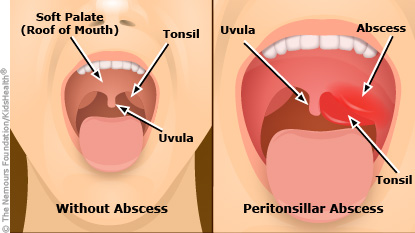Peritonsillar Abscess: How to Care for Your Child
A peritonsillar abscess is an infection in the back of the throat around the tonsil. It usually goes away with proper treatment.


A peritonsillar abscess is a complication of tonsillitis (infection of the tonsils). A few different bacteria can cause it, but most cases are due to group A beta hemolytic streptococci bacteria, which also cause strep throat.
A peritonsillar abscess starts when tonsillitis spreads to the nearby tissues and then develops into a collection of pus. The collection can push the tonsil out toward the uvula, which hangs in the middle of the throat, making swallowing difficult and speech sound muffled. The swollen tissue is painful, and makes it hard to open the mouth. If the infection becomes severe, other complications can occur.
If the infection is caught early, only antibiotics might be needed. However, once there is an abscess (a pus collection), it needs to be drained. Most kids will have the abscess drained in the operating room. Sometimes the tonsils will need to be removed at a later time.
Your child was treated for a peritonsillar abscess including antibiotics, hydration with IV fluids, and surgical drainage as appropriate. Your child is doing better now and can continue treatment at home.

-
Be sure to give all doses of any oral antibiotics that were prescribed.
-
For pain, a medication may help your child feel better.
-
Encourage your child to drink plenty of fluids.
-
Give your child a soft, bland diet and avoid hard, salty, spicy, or acidic foods for a few days. Gradually return to your child's regular diet as the pain allows.
-
Your child can return to normal activities when your health care provider says it's OK.
-
Follow up with your ENT health care provider as directed.

Your child:

Your child:
-
Has trouble breathing or swallowing.
-
Cannot open the mouth.
-
Develops trouble moving the neck.
-
Has bleeding from the throat or mouth.
-
Has increased swelling in the neck.
-
Has chest pain.
-
Appears dehydrated; signs include dizziness, drowsiness, a dry or sticky mouth, sunken eyes, producing less urine or darker than usual urine, crying with little or no tears.